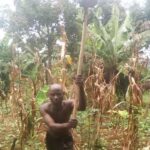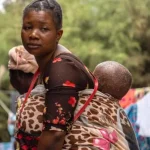Hundreds of thousands of people are “slowly starving” in Kenyan refugee camps after US funding cuts reduced food rations to their lowest ever levels, a United Nations official has told the BBC.
The impact is starkly visible at a hospital in the sprawling Kakuma camp in the north-west of the East African nation. It is home to roughly 300,000 refugees who have fled strife in countries across Africa and the Middle East.
Emaciated children fill a 30-bed ward at Kakuma’s Amusait Hospital, staring blankly at visitors as they receive treatment for severe acute malnutrition.
One baby, Hellen, barely moves. Parts of her skin are wrinkled and peeling, leaving angry patches of red – the result of malnutrition, a medic tells the BBC.
Across the aisle lies a nine-month-old baby, James, the eighth child of Agnes Awila, a refugee from northern Uganda.
“The food is not enough, my children eat only once a day. If there’s no food what do you feed them?” she asks.
James, Hellen and thousands of other refugees in Kakuma depend on the UN’s World Food Programme (WFP) for vital sustenance.
But the agency had to drastically reduce its aid operations in many countries after President Donald Trump announced sweeping cuts to US foreign aid programmes earlier this year, as part of his “America First” policy.
The US had provided around 70% of the funding for the WFP’s operations in Kenya.
The WFP says that as a result of the cuts, the agency has had to slash the refugees’ rations to 30% of the minimum recommended amount a person should eat to stay healthy.
“If we have a protracted situation where this is what we can manage, then basically we have a slowly starving population,” says Felix Okech, the WFP’s head of refugee operations in Kenya.

Outside Kakuma’s food distribution centre, the sun beats down on the dry, dusty ground and security officers manage queues of refugees.
They are led into a holding centre and then a verification area. Aid workers scan the refugees’ identity cards and take their fingerprints, before taking them to collect their rations.
Mukuniwa Bililo Mami, a mother of two, has brought a jerrycan to collect cooking oil, along with sacks for lentils and rice.
“I am grateful to receive this little [food] but it is not enough,” says the 51-year-old, who arrived in the camp 13 years ago from South Kivu, a region in conflict-hit eastern Democratic Republic of Congo
Ms Mami says the refugees used to “eat well” – three meals a day. But now that rations are at 30% of their usual amount, the food she has been given is not enough to last one month, let alone the two that she has been asked to stretch it for.
She has also been affected by another casualty of the cuts – cash transfers.
Until this year, the UN was giving around $4m (£3m) in cash directly to refugees in Kenya’s camps each month, intended to allow families to buy basic supplies.
Ms Mami, who is diabetic, used the cash to buy food, like vegetables, which were more appropriate for her diet than the cereals handed out at the distribution centre.
Now, she is forced to eat whatever is available.
She also used the money to start a vegetable garden and rear chicken and ducks, which she sold to other refugees, at a market.
But the discontinuation of the cash transfers, locally known as “bamba chakula”, has meant that the market faces collapse.
Traders like Badaba Ibrahim, who is from the Nuba Mountains in Sudan, are no longer able to extend lines of credit to fellow refugees.
The 42-year-old runs a retail shop in the local shopping centre. He says his customers, now unable to purchase food, at times camp at his shop all day, begging for help.
“They will tell you, ‘My children have not eaten for a full day,'” Mr Ibrahim says.
Elsewhere in the Kakuma camp, 28-year-old Agnes Livio serves up food for her five young sons.
They live in a cubicle, which is roughly 2m (6ft 6in) by 2m made from corrugated iron sheets.
Ms Livio serves the food on one large plate for all to share. It is the family’s first meal of the day – at 1400.

“We used to get porridge for breakfast but not anymore. So, the children have to wait until the afternoon to have their first meal,” says Ms Livio, who fled from South Sudan.
Back at Amusait Hospital, medics are feeding a number of malnourished infants through tubes.
Three toddlers and their mothers are being discharged – back to the community where food is scarce and conditions are deteriorating.
And the prospect of more funding is not very promising and unless things change over the next two months, the refugees are staring at starvation come August.
“It is a really dire situation,” admits Mr Okeck.
“We do have some signals from some one or two donors about support with that cash component.
“But remember, the very kind and generous US has been providing over 70% – so if you’re still missing 70%… those prospects are not good.”














